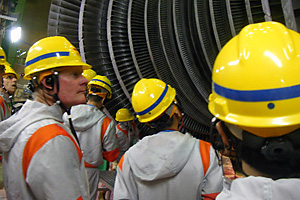With repairs complete and some approvals already given, the restart is approaching of the Kashiwazaki Kariwa reactors, shut down since July 2007.
Seven reactors at the world's biggest nuclear power plant were shaken hard by the Niigata Chuetsu offshore earthquake of 16 July 2007. At Kashiwazaki Kariwa, three units were already shut down for maintenance, while the three in operation shutdown automatically as did one that was in the process of starting up. All of them remained in a safe state throughout the 6.8 magnitude earthquake, according to the third and final report from the International Atomic Energy Agency. An IAEA group was invited to visit by Japanese authorities and the plant owner Tokyo Electric Power Company (Tepco).
Levels of seismic ground motion greatly exceeded those estimated in the plant's design process but there is now scientific consensus about why this happened the IAEA said. With new knowledge, geologists have found the potential strength of a future earthquake at the site could be 'much higher' than that of the one in 2007. A number of precautions have been identified and taken with regards to possible future tremors.
With these precautions taken on board and a wide array of repairs made to the entire plant site, it is now up to local and national authorities to consider the restart of the reactors.
Nearby Kashiwazaki City has lifted a suspension order on the seventh reactor at the plant last week and meetings are planned between local people and bodies such as Japan's Nuclear Industrial Safety Agency (Nisa) concerning the potential restarts. Tepco is understood to have submited a trial operation plan for unit seven to Nisa for approval.
Tepco would be glad to regain some of its lost generation capacity for the summer months, when air conditioning needs push demand to its highest. The company lost money for the first time in FY2007, and this continued into FY2008 due to the loss of output from ther 8000 MWe power plant and the costs of repairs as well as the costs of replacement power from other sources and the import of fossil fuels.
Great shakes Although the Kashiwazaki Kariwa plant was designed to withstand an earthquake of up to 6.5 on the Richter scale in accordance with Japanese regulations, it was struck by one of 6.8 centred just 16 kilometres away. The maximum ground acceleration recorded at unit 1 was 680 Gal, compared to a design value of 273 Gal. |





_47120.jpg)

_23621.jpg)






